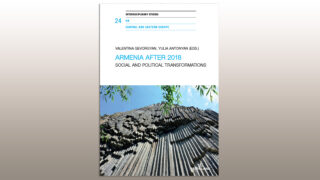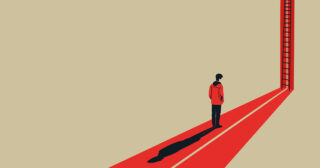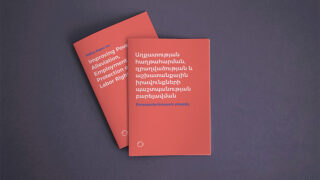Most of the world’s poor people work. They work for a living, however they do not earn enough to make ends meet in a minimally acceptable way. This issue persists not only in developing countries, but in developed ones too. “Working poor” is not a widespread term, instead, “the poor” is most frequently used in literature and policy documents, because the terms “working” or “employed” seem to be features of welfare.[1] The terminological distinction, however, is important for a deeper understanding of the problem and for proposing policies tackling it.
The issue of in-work poverty is widespread and has been the focus of researchers for quite some years now. Researchers in the USA use the term “the working poor,” while “in-work poverty” is a more prevalent term in Europe.[2] A working poor is the person who works, yet is poor. [3]
The idea that the working poor are mainly engaged in the “liberal” economies and in-work poverty is a result of a lack of well-organized laborforce and respective regulations, is contested. However, because the phenomenon of the working poor is widespread all over the world, including in developed and rich countries, [4] it follows that in-work poverty is a global issue. Many European states do acknowledge that this is a problem and are taking action to address it. One way of addressing it is setting a reasonable minimum wage threshold that allows the wage-earners to meet their and their family members’ basic needs and to withstand social and economic shocks.[5]
It is, of course, quite a milestone that in-work poverty is already acknowledged by many governments, which are trying to tackle it, however, the limited understanding of the nature of the phenomenon is a looming issue. There is, for example, an understanding that poverty can be reduced if wages are increased or if inadequate wages are adjusted. While these statements are partly true, they are misguiding at the same time, because the wages are not the only indicative of poverty.[6] Here is an example: a family member that is earning a decent wage can become a working poor if this person is the only wage-earner in the family and has dependent children. According to the ILO, having a job does not protect households from the risk of poverty.[7] Moreover, according to the data of that same organization, two-thirds of the wage-earners in developing countries live in extreme or medium-level poverty.[8] According to data from 2018, 8% of people who work, live in extreme poverty, while the correlation between having a job and poverty reduction is not direct and is still contestable.[9] The labor market of postmodern societies is characterized by unequal wages, and huge gaps between the lowest and highest wages, therefore for those people whose earnings are equal or close to the minimum wage, having a job does not yet mean not being poor.[10]
The phenomenon of “the working poor,” “the wage-earning poor” or “in-work poverty” has not been researched at length in Armenia and the existing studies and statistics are quite limited. This article is part of a larger research[11], and is an attempt, inter alia, to briefly touch upon the public perceptions collected in two regions of Armenia – Gegharkunik and Shirak – on the notions of employment and poverty, the working poor and in-work poverty.
In its “Poverty Reduction Strategy Program”[12], the Armenian government states that the main reason for poverty is unemployment, yet it also notes that more than 1/5 of the employed population is extremely poor, while 45-47% of the employed population is simply poor.[13] Governments and researchers all around the world, including the Armenian government, see job creation as an important precondition for reducing poverty and its extreme form. They see participation in the labor market as the most important factor impacting poverty. It is especially with the lack of a job that the likelihood of falling into poverty or extreme poverty increases. For the Armenian government, implementation of an employment strategy is the milestone with which extreme poverty can be reduced, “because it is through a job, not through constant social support, that a person gets a vision.“[14] Some of our research participants share the idea that “a working man cannot be poor.”
“A working man can never be poor. A working man is always rich by the soul too.”
Woman aged 30-44, Artik, Shirak Region
Findings from various studies show, however, that employment in certain sectors increases the likelihood of being poor as a worker in that particular sector. Researchers are distinguishing the cohorts which are most likely to be both employed and poor, those being low-skilled or unskilled workers, who work in low-paid jobs without employment contracts or with standard contracts; self-employed people (solo dependent self-employed) and flexibly employed workers (such as temporary agency workers etc); involuntary part-time workers; casual workers, those whose job comes informal platforms, such as phone apps or from places where temporary workers are sought(the so-called “faylabazar” in Armenia, for example).[15]
Our respondents also emphasize that holding a job and having stable employment does not always help overcome poverty and the reasons why people may work and still be poor, according to them, include the following factors.
- Low wages, the low threshold of the minimal wage,
- Unequal development of regions,
- Having underage members in the household,
- Families with many children,
- Having a family member with a disability,
- Being an informal worker,
- Doing agriculture,
- Financial illiteracy,
- Substance use dependence, gambling, etc.
Research participants first and foremost emphasize the fact that wages are very low in Armenia, and having a job with a low wage does not pull a person out of poverty.
“You go with two higher education diplomas and are still offered 80.000 drams of wages.”
Woman aged 30-44, Chambarak, Ghegharkunik Region
“This person is working, the wages are low, is the only earner in the household and it’s not enough. Or, there are three underage children in the family.”
Woman aged 30-44, Artik, Shirak Region
Can the minimum wage really reduce poverty? One may jump to the quick answer of “yes,” as the main goal of setting a minimum wage is to protect the rights of wage earners and their family members. However, the efficacy of the minimum wage in diminishing poverty levels is increasingly being questioned. Various researchers argue that for substantial poverty reduction and the enhanced protection of citizens, states should prioritize directing resources and efforts toward those in poverty and extreme poverty. This includes safeguarding the rights of those working in the informal economy, where the minimum wage doesn’t effectively support the poor and extremely poor. Notably, the minimum wage predominantly applies to formal workers who, albeit minimally, already benefit from some level of protection.[16]
In the meanwhile, collective contracts and collective bargaining around wages, specifically around the minimum wage, could have a significant impact on the fight against poverty. Findings from various studies show that there is no supportive evidence that setting a minimum wage creates opportunities for fighting against extreme poverty, however, at the same time it is noteworthy that it has a significant role in the fight against poverty in general. Setting a minimum wage has contributed to some reduction of poverty in certain countries and has somewhat made a positive impact on groups of workers in the formal sector of the economy.[17]
Interestingly, our research participants, those particularly in rural communities, attach a big importance to a “public job” (state job) which they believe is a safeguard for a stable income, stability and has the capacity to save people from poverty. By saying a “public job” they mean any job in the formal economy regardless of the sector and even at the minimum wage level which, however, is stable. For example, working as a shop attendant and being a formally registered worker are viewed as holding a public job.
“My neighbor’s daughter graduated 4 years ago, it is only now that she has been offered to work at a kiosk in Gavar town, a state job.”
Woman aged 30-44, Noratus, Gehgarkunik Region
Being self-employed, and doing some sort of economic activity that earns profits is not considered a job, the research participants do not consider it to be employment.
In this context, diversification of the community economy is emphasized so that a workplace is not limited to a shop or some private business.
“We need factories. All over Artik, we only have shops that pay 50.000 drams. How are people supposed to survive? There are no jobs. Schools and kindergartens and such are too few to offer jobs to all.”
Woman aged 30-44, Artik, Shirak Region
A family’s vulnerability to poverty increases with underage family members, especially when the number of children is big. Research participants believe that when only one adult works in households with many children, then it is already a bearing ground for poverty.
According to respondents, another contributing factor to poverty is the reliance on agriculture as the primary source of income. They argue that despite the considerable efforts invested in growing crops, the prices for these agricultural products are disproportionately low. On one hand, they highlight that farming crops and raising animals can play a significant role in poverty reduction, especially within rural communities, as these activities meet subsistence needs. However, on the other hand, they note that while these agricultural activities are crucial, they alone are insufficient for breaking the cycle of poverty. Rural participants in the research stress that plant and animal farming provide sustenance for the immediate day-to-day needs, “food for the day”. These activities are seasonal, leading to better circumstances during summer months compared to the harsher realities of winter. Increased utility costs during winter exacerbate vulnerabilities, with electricity and gas becoming particularly unaffordable for many, further impacting their economic stability.
Agriculture also contributes to the reproduction of poverty among the elderly. Agriculture does not accrue pensionable working experience based on which pension is calculated later on in life.
“There is one more thing: now people are getting pension based on the years they worked during the “kolkhoz” period. If this generation is no longer alive, where are the current people without jobs going to get their pensions from? What are we supposed to do? We have no job. Back in the days, we were working in the fields, this counted as pensionable working experience. Now the peasant is working in the fields, but this job is not pensionable. All their lives, peasants are toiling in the fields and yet not accruing any pension.”
Man aged 30-40, Marmashen, Shirak Region
For employment to meaningfully lift people out of poverty, it must be of good quality Decent jobs—those with fair working hours (without excessive overtime), reasonable wages, safe work environments, and social protection—are crucial for sustainable development and poverty eradication. A robust and effective policy regulating labor markets and employment is essential to solidify the positive relationship between employment and poverty reduction, encouraging investments in this realm. Special attention should be paid to youth employment, given that poverty rates are consistently higher among young people worldwide across all regions. Moreover, there’s a heightened probability that employed youth might still experience poverty. We want to emphasize the gaps that exist in jobs employing young laborforce and these gaps pertain to both the nature of jobs, their quality and the wages, all of which should be in the focus of policy developers. The duress of the youth in the labor market can have a long-term negative impact on them, as well as on the communities and the state, as in the long run, it may generate various social issues. [18]
The persistent in-work poverty rings the alarm that the labor market is not fully using its potential. In-work poverty is already a reality and it should force the policy-makers and decision-makers to adopt such strategies that promote decent work and quality employment for all. We propose:
- To improve the policies developed and implemented in employment, poverty, and affiliated areas with a focus on tackling the issue of the working poor.
The phenomenon of in-work poverty is quite complex, therefore approaches to tackle it must be comprehensive too. At the core of these policies should be extensive research identifying the most vulnerable areas of employment from the perspective of poverty, the cohorts of workers most vulnerable to poverty, and the gendered, age, regional, and other characteristics of in-work poverty.
- To improve assessment of in-work poverty.
In order to address the issue in a more targeted and effective manner, it is necessary to develop adequate research tools that will serve to improving comprehension and measurement of non-standard employment, especially of unstable employment and the so-called “new forms of employment”, to extensively analyze the information received and to create research-based policies.
- To ensure continuous education and training, based on needs and opportunities for workers, the working poor.
- To improve the social protection of the vulnerable workers and to make social assistance programs more targeted.
- To incorporate the issue of poverty or in-work poverty in discussions on labor, employment, poverty, and social protection as a cross-cutting issue and to organize public hearings around them.
Translated by Anna Shahnazaryan
[1] Lohmann, H․ & Marx, I. (2018). Handbook on In-Work Poverty. Retrieved from https://www.elgaronline.com/edcollbook/edcoll/9781784715625/9781784715625.xml
[2] Ibid.
[3] Ibid.
[4] Hick, R., Marx, I. (2022). Poor Workers in Rich Democracies: On the Nature of In-Work Poverty and Its Relationship to Labour Market Policies. Retrieved from https://docs.iza.org/dp15163.pdf
[5] Ibid.
[6] Although it is also correct that the wage is one of the main indicators of poverty.
[7] Sahakyan, M., Karapetyan, L. (2021). The Phenomenon of the Working Poor in Armenia. Work and Social Justice, Yerevan (in Armenian). Retrieved from https://library.fes.de/pdf-files/bueros/georgien/17944-20210722.pdf
[8] ILO․ (2017)․ World Employment Social Outlook: trends 2017, Retrieved from https://www.ilo.org/wcmsp5/groups/public/—dgreports/—dcomm/—publ/documents/publication/wcms_541211.pdf
[9] ILO․ (2019)․ The working poor or how a job is no guarantee of decent living conditions. Retrieved from: https://ilo.org/wcmsp5/groups/public/—dgreports/—stat/documents/publication/wcms_696387.pdf
[10] Banoli, G. (2007). “Time Matters: Postindustrialization, New Social Risks and Welfare State Adaptation in Advanced Industrial Democracies,” Comparative Political Studies 40 (5): 495-520.
[11] Research in progress by “Socioscope” NGO. The focus group phase of the research was completed in August 2023 with 40 representatives from a cohort aged between 30 and 44.
[12] Adopted in 2003.
[13] Sahakyan, M., Karapetyan, L. (2021). The Phenomenon of the Working Poor in Armenia. Work and Social Justice, Yerevan (in Armenian). Retrieved from https://library.fes.de/pdf-files/bueros/georgien/17944-20210722.pdf
[14] Aravot Daily․ (2023). “There Shall be No Extremely Poor Person by 2026 in Armenia: Narek Mkrtchyan” (in Armenian). Retrieved from: https://www.aravot.am/2023/03/20/1329943/
[15] An Horizon 2020 Research and Innovation Project․ (2023). Main Findings and Policy Proposals. Retreived from: https://workingyetpoor.eu/wp-content/uploads/2023/02/Main-findings-and-policy-proposals_brochure.pdf
[16] Saget, C. Minimum wage – does it cut poverty? Retrieved from: https://library.fes.de/pdf-files/gurn/00118.pdf
[17] Ibid.
[18] ILO․ (2019)․ The working poor or how a job is no guarantee of decent living conditions. Retrieved from: https://ilo.org/wcmsp5/groups/public/—dgreports/—stat/documents/publication/wcms_696387.pdf
References
- Sahakyan, M., Karapetyan, L. (2021). The Phenomenon of the Working Poor in Armenia. Work and Social Justice, Yerevan (in Armenian). Retrieved from https://library.fes.de/pdf-files/bueros/georgien/17944-20210722.pdf
- An Horizon 2020. Research and Innovation Project. (2023). Main Findings and Policy Proposals. Retrieved from: https://workingyetpoor.eu/wpcontent/uploads/2023/02/Main-findings-and-policy-proposals_brochure.pdf
- Banoli, G. (2007). Time Matters: Postindustrialization, New Social Risks and Welfare State Adaptation in Advanced Industrial Democracies. Comparative Political Studies 40 (5): 495-520
- Hick, R., Marx, I. (2022). Poor Workers in Rich Democracies: On the Nature of In-Work Poverty and Its Relationship to Labour Market Policies. Retrieved from: https://docs.iza.org/dp15163.pdf
- ILO․ (2019)․ The working poor or how a job is no guarantee of decent living conditions. Retrieved from: https://ilo.org/wcmsp5/groups/public/—dgreports/—stat/documents/publication/wcms_696387.pdf
- ILO․ (2017)․ World Employment Social Outlook: trends 2017, Retrieved from: https://www.ilo.org/wcmsp5/groups/public/—dgreports/—dcomm/—publ/documents/publication/wcms_541211.pdf
- Lohmann,H․ & Marx, I. (2018). Handbook on In-Work Poverty. Retrieved from https://www.elgaronline.com/edcollbook/edcoll/9781784715625/9781784715625.xml
- Saget, C. Minimum wage – does it cut poverty? Retrieved from: https://library.fes.de/pdf-files/gurn/00118.pdf
“EU4LabourRights: Increasing Civic Voice and Action for Labour Rights and Social Protection in Armenia:” Project is implemented by OxYGen Foundation, Socioscope NGO, “Asparez” Journalists’ Club NGO, Armenian Progressive Youth NGO, Media Diversity Institute – Armenia in cooperation with Protection of Rights without Borders NGO, and Eurasia Partnership Foundation. The Project is funded by the European Union.This publication was produced with the financial support of the European Union. Its contents are the sole responsibility of Socioscope NGO, and do not necessarily reflec the views of the European Union.






